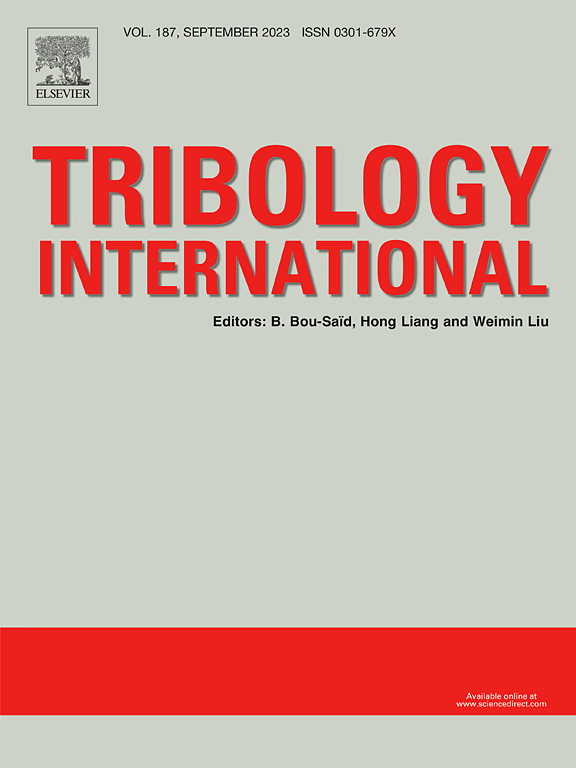定向能沉积与层间重熔相结合,通过晶粒细化提高镍钛的耐磨性
IF 6.1
1区 工程技术
Q1 ENGINEERING, MECHANICAL
引用次数: 0
摘要
镍钛涂层的定向能沉积备受关注,但其性能难以满足工程领域日益增长的要求。为了细化晶粒以提高耐磨性,本研究提出了一种通过定向能沉积制造镍钛合金的新型层间重熔方法。比较全面地分析了激光层间重熔参数对晶格结构、相变行为、微观结构、结晶演变和显微硬度的影响。层间重熔后显示出良好的成型性,而高能量密度则导致微观结构细化,并在树枝状晶粒之间观察到共晶区。晶粒尺寸随着重熔速度的增加而减小,这是由于冷却速度越快,过冷程度越高,成核点越多。层间重熔速度越快,显微硬度(586 HV0.2)越高,耐磨性越强,这是因为其晶粒尺寸更细,晶界明显强化。往复滑动磨损实验表明,层间重熔后耐磨性得到改善,特别是在负载为 30 N 时,比磨损率为 1.35 * 10-4mm3/Nm,仅为未处理样品的 47%。本研究提出了一种实现增强涂层微硬度和滑动磨损性能协同增强的技术,为镍钛涂层在工程中的应用提供了理论依据,并拓展了增材制造领域。本文章由计算机程序翻译,如有差异,请以英文原文为准。
Directed energy deposition combined with interlayer remelting for improving NiTi wear resistance by grain refinement
Directed energy deposition of NiTi coatings has received much attention, however, its performance is difficult to meet the increasing requirements in the engineering field. In order to refine the grains to improve wear resistance, a novel interlayer remelting method for fabricating NiTi alloys by directed energy deposition is proposed in this study. The influence of laser interlayer remelting parameters on lattice structure, phase transformation behavior, microstructure, crystallographic evolution, and microhardness was thoroughly analysed in comparison. Good formability is demonstrated after interlayer remelting, while the high energy density leads to microstructure refinement and eutectic regions are observed between dendrites. The grain size decreases with increasing remelting speed, which is due to the faster cooling rate having a greater degree of subcooling with more nucleation points. The faster interlayer remelting speed shows a higher microhardness (586 HV0.2) with higher wear resistance, which is attributed to its finer grain size and significant grain boundary strengthening. Reciprocating sliding wear experiments show that the wear resistance is improved after interlayer remelting, especially at a load of 30 N, the specific wear rate is 1.35 * 10−4mm3/Nm, which is only 47 % of that of the untreated sample. This study proposes a technique to achieve synergistic enhancement of microhardness and sliding wear properties of reinforced coatings, which provides a theoretical basis for the application of NiTi coatings in engineering and extends the field of additive manufacturing.
求助全文
通过发布文献求助,成功后即可免费获取论文全文。
去求助
来源期刊

Tribology International
工程技术-工程:机械
CiteScore
10.10
自引率
16.10%
发文量
627
审稿时长
35 days
期刊介绍:
Tribology is the science of rubbing surfaces and contributes to every facet of our everyday life, from live cell friction to engine lubrication and seismology. As such tribology is truly multidisciplinary and this extraordinary breadth of scientific interest is reflected in the scope of Tribology International.
Tribology International seeks to publish original research papers of the highest scientific quality to provide an archival resource for scientists from all backgrounds. Written contributions are invited reporting experimental and modelling studies both in established areas of tribology and emerging fields. Scientific topics include the physics or chemistry of tribo-surfaces, bio-tribology, surface engineering and materials, contact mechanics, nano-tribology, lubricants and hydrodynamic lubrication.
 求助内容:
求助内容: 应助结果提醒方式:
应助结果提醒方式:


